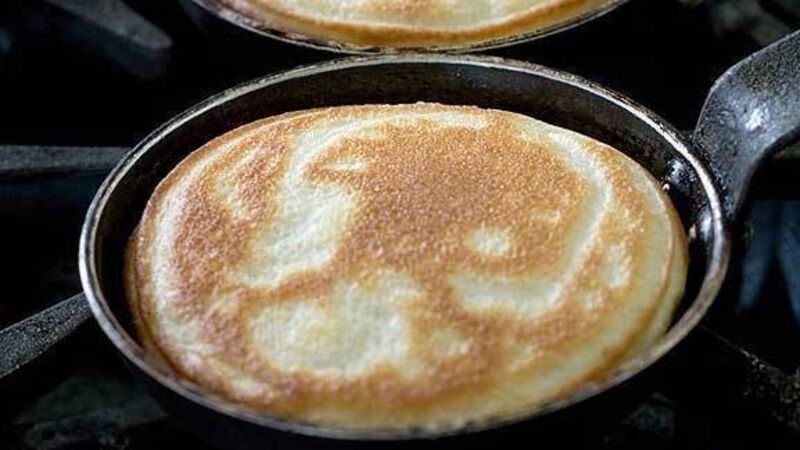Basic Pancake Batter and good things to serve with it

For many, pancakes were the thin crêpes that our Mam’s rustled up on Shrove Tuesday and we then forgot about for the rest of the year. Made in minutes from a simple batter it’s amazing that they were often just an annual treat.
In our house, however, they were my perennial standby, when I needed to feed tired and grouchy children in a hurry. I’d put the pan on the Aga, shoot a mug of flour into a bowl, add caster sugar and a pinch of salt, crack a few eggs into the centre and whisk in some milk to make a thin batter. I’d melt some butter in a saucepan, grab a lemon and a bowl of caster sugar. By then the pan would be hot so I’d whisk a little melted butter into batter (that stops the batter sticking) and pour in a small ladle of batter into the very hot pan. Within seconds, it would have set on one side, so I’d flip it over when it was speckled and golden a few seconds later. I’d turn it onto a plate, brush with melted butter, sprinkle with caster sugar and squeeze on a little fresh lemon juice. Finally, I’d roll or fold it into a fan shape.
Nowadays my grandchildren love pancakes, they also slather them with chocolate spread with or without toasted hazelnuts and sliced banana. They also love savoury pancakes, particularly with mushrooms or ham and cheese in the French style.
They are quintessential fast food but don’t just stop with crêpes. Remember virtually every culture around the world has at least one pancake recipe.
Think Moroccan Baghrir, Chinese thin white flour pancakes called Moo shoo row, Vietnamese Banh xeo and Korean Pa ‘chon — both semolina flour pancakes made from a similar type batter but served with different accompaniments. In India pancakes are made not just from wheat flour but also rice flour, split peas, mung beans, chickpea flour depending on the region. There are Mexican pancakes, Lithuanian pancakes, Russian pancakes, Italian Fazzoletti and Crespelle, Scotch pancakes, American pancakes — and that’s just the beginning. The simple little crumpets or drop scones are another gem of a recipe. Again the batter is made in the length of time it takes to heat a cast-iron pan. Spoonfuls of batter are dropped onto the pan on a medium heat, as soon as the bubbles rise and burst, flip them to cook on the other side. Eat them warm with butter and honey or apple jelly.
Serves 6 — makes 12 approx.
Pancakes are far too simple and delicious to be served only on Shrove Tuesday.
Whip up a batter with flour and milk and in a matter of minutes you will be flipping delicious speckled pancakes.
Sieve the flour, salt, and sugar into a bowl, make a well in the centre and drop in the lightly beaten eggs. With a whisk or wooden spoon, starting in the centre, mix the egg and gradually bring in the flour. Add the liquid slowly and beat until the batter is covered with bubbles. (If they are to be served with sugar and lemon juice, stir in an extra tablespoon of caster sugar and the finely grated rind of half a lemon.)
Let the batter stand in a cold place if you have time. Just before you cook the pancakes stir in 3-4 dessertspoons melted butter. This will make all the difference to the flavour and texture of the pancakes and will make it possible to cook them without greasing the pan each time.
Heat a non-stick pan over a high heat, pour in a small ladleful of batter or just enough to film the base of the pan. The batter should cook immediately, loosen around the edges with a rubber slice, flip over and cook for a few seconds on the other side. Slide onto a plate, serve with your chosen filling either sweet or savoury.
Stir a few tablespoons of freshly chopped herbs into the batter, well-seasoned mushrooms or Mushroom á la crème, bacon, crispy pieces of chicken, mussels, shrimps or whatever tasty bits you come across in the fridge, added to mushroom á la crème, goat cheese, tomato fondue and pesto.
Makes about 9 pancakes
Put the dal in a bowl. Add 1 litre (32fl oz) water and soak for 5 hours. Drain.
Start your food processor with the metal blade in place. (An electric blender will also do.) Through the funnel, drop in the ginger, garlic and green chilies. When they are minced, stop the machine and put in all the drained mung dal. Start the machine again and let the dal turn paste-like. Stop the machine and add 110ml (4fl oz) water, the salt, baking soda and turmeric. Run the machine for another 2 minutes to make a thick batter. Empty the batter into a bowl and mix in the green coriander and the onion thoroughly.
Now see that you have everything near you that you will need to make the pancakes. You need an 18 – 20.5cm (7-8-inch) non-stick frying pan. Near it on your counter place a small bowl of oil with a teaspoon, a rounded ladle for spreading out the batter, your bowl of batter, a cup or ladle to hold about 70ml (2 3/4fl oz), and a plastic spatula. You will also need a plate lined with a long piece of foil that both lines and covers the pancakes as they get made plus another plate to upturn and cover the foil package.
Pour 1 teaspoon of oil into the non-stick frying pan. Spread the oil around by tilting the pan. Set the pan on medium-low heat. Wait for the oil to heat up. When the oil is hot, stir the batter well and remove 70ml (2¾fl oz) from the bowl. Plop it down in the centre of your heated pan. Let it sit for 3-4 seconds. Now place the rounded bottom of your ladle very gently on the blob of batter. Using a slow, gentle and continuous spiral motion, spread the batter outwards with the back of the ladle. Make a pancake that is about 15cm (6 inches) in diameter. Dribble ½ teaspoon oil over the pancake and another ½ teaspoon just outside its edges. Using the plastic spatula, spread out the oil and also smooth out the ridges on the pancake. Cover the pan and let the pancake cook for about 2 minutes, or until the underside turns a nice reddish colour. Uncover and turn the pancake over. Cook the second side for about 1 1/2 minutes, or until it develops small red spots. Remove the pancake and put it on the foil-lined plate. Cover, first with the extra foil and then with the second upturned plate. Make all the pancakes this way, making sure to stir the batter each time. Stack the pancakes on top of each other, covering the stack each time. If not eating immediately the entire foil packet could be heated in a medium oven for 15 minutes. Or you can heat up a pancake at a time in the microwave oven for about 20-30 seconds.
Serves 4
Julija — known to many from our stall at the Midleton Farmers Market has worked with us for nine years. She’s a super cook and here is her recipe.
First, measure the buttermilk into a bowl and sprinkle the baking soda on top and leave for 3 to 4 minutes to allow the mixture bubble. Whisk the egg, salt, and sugar into the buttermilk mixture. Next, slowly add the flour to the batter by whisking all the time until mixture appears to have an even consistency. Set aside. The batter should be thick and fall very reluctantly off the spoon.
Heat a frying pan on a medium-high heat. Add a little vegetable oil. Fill the pan with 5-6 tablespoons of batter spaced evenly apart. Fry until golden brown, flip once bubbles have appeared on the surface and popped (if the pan is too hot, turn down the heat). Repeat frying process until all of the batter is used. Serve with dips (see below).
Mix 2 tablespoons sour cream (crème fraiche) with 2 tablespoons raspberry jam or try sour cream with brown sugar sprinkled on top.
At a Slow Food event in Ballymaloe Cookery School on March 6 at 7pm, Sally McKenna, author of Extreme Greens, will present Understanding Seaweed. She will talk about this unique food and tell you how to find and harvest it and how to use it in the kitchen. There will be a tasting of different types of seaweed and some recipe suggestions.
Ireland is rich in seaweed and macroalgae has been part of the Irish diet going right back to prehistory. It was valued in pre-famine times as a medicine, fertiliser and a food. Slow Food/Non Slow Food Members €6/€8, coffee and homemade biscuits on arrival. Proceeds to the East Cork Education Project. 021 4646785.
Cooking for Baby, Natural and Wholesome Recipes — Ballymaloe Cookery School on March 7 from 2pm to 5.30pm; cost: €50. Phone 021 4646785; www.cookingisfun.ie















